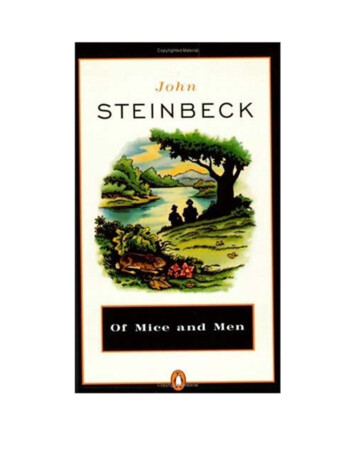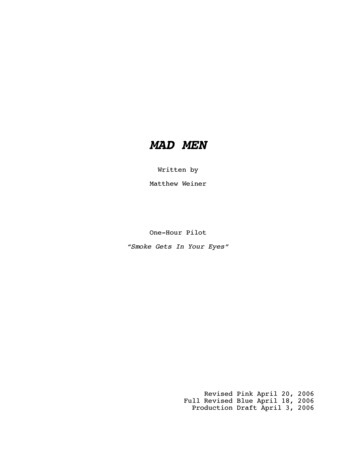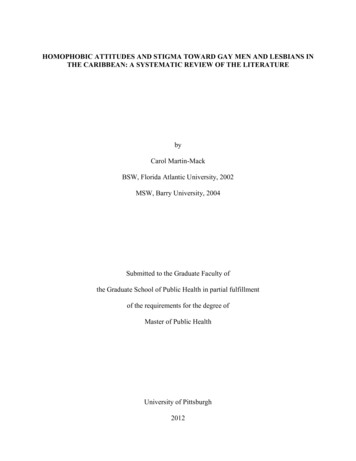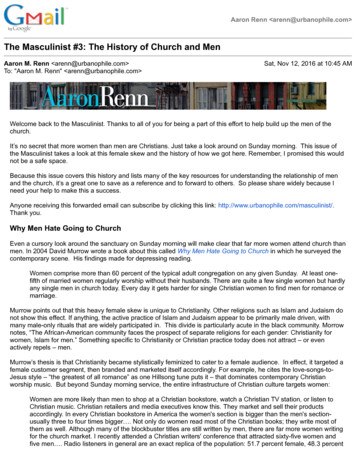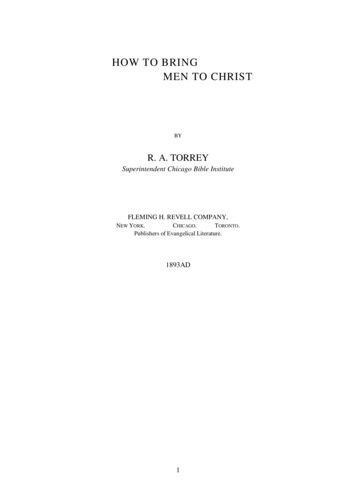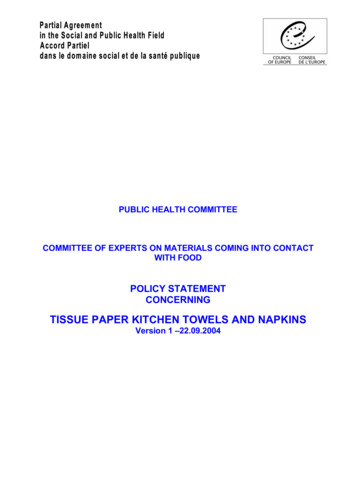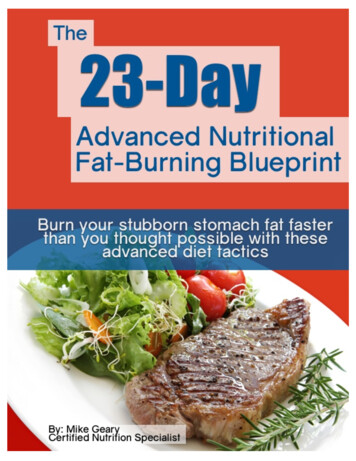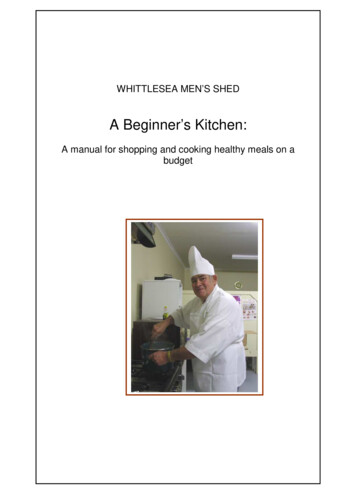
Transcription
WHITTLESEA MEN’S SHEDA Beginner’s Kitchen:A manual for shopping and cooking healthy meals on abudget
A Beginner’s Kitchen.Introduction.This manual has been created with the assistance of a community grant fromthe City of Whittlesea and the collaboration of staff and volunteers of PlentyValley Community Health; especially Angela Robinson and Meaghan vanLoenen, without their assistance and advice the manual would not havebecome a reality.The book is directed at mature men who live alone, have lost a partner or arerequired to assume the role of planning, shopping and cooking meals due totheir partner’s inability. It is not intended to make a chef of the user, its purposeis to encourage confidence and ability to prepare healthy meals on a limitedbudget rather than take the easy options of expensive convenience food.To facilitate this aspect, the manual is divided into four seasons, each seasonhaving breakfast, lunch and dinner menus for fourteen days, this being theperiod between government pension payments.The menus are set out in this manner for convenience and meals should beselected as the user sees fit. The criteria for the inclusion of these recipes werethat the preparation and the cooking time be short.I hope that this manual will make your life easier, healthier and longer.A.J (Sandy) NortonMelbourne, AustraliaNovember 2010Note:Every recipe in this book has been written to serve one person.This work is copyright. Apart from any use permitted under the Copyright Act1968, no part may be reproduced by any process, nor may any other exclusiveright be exercised, without the permission of A. J. Norton, Melbourne, Victoria,Australia, November 2010.Not –for- profit organizations are free to use all or part of this document without reference to thecopyright holder.This book is available electronically at www.pvch.org.au and www.mensshed.orgProudly supported by City ofWhittlesea2WhittleseaMen’s Shed
“I’ve had a review of this ‘Cookbook’ and think that it is GREAT! As a matter offact I will probably use some of the recipes myself. It has some clever ideas toget us all eating healthily but importantly tastefully! Being approved by thePlenty Valley Community Health dietician means that the AMSA canrecommend this with confidence and I strongly encourage it’s inclusion on theAustralian Men’s Shed Association website or include the link.”Gary GreenCommunity Engagement CoordinatorAustralian Men’s Shed AssociationAcknowledgementsThe creation of this manual came about through the vision and hard work ofSandy Norton from the Whittlesea Men’s Shed, who has devoted many hours ofhis time to its production.Many thanks to Sandy and to the following people who also provided valuableinput Eddy RoksAngela RobinsonJoe FranceseJulie McBrideNihal SamaraVivienne BlandMeaghan van LoenenEmma HughesLuke NeillJeremy HearneTeam Leader, Population Health,Plenty Valley Community HealthSome of the men cooking3
ContentsIntroduction .Page2Seasonal cooking, healthy eating 5Dietary Guidelines .6, 7Weight Gain and Healthy Eating for Men 51-70 years .8Use of herbs 9Conversion tables (Volume and Temperature and Pantry Items) .1014 Day Plan for Autumn 1114 Day Plan for Winter .1214 Day Plan for Spring .1314 Day Plan for Summer .14Autumn Recipes Details 15-36Winter Recipes Details .37-51Spring Recipe Details 53-74Summer Recipe Details 75-96Index 97-99Feedback details1004
What should a man eat? - Seasonal Cooking:Everything is at the lowest price when in season and plentiful, so to keep withina budget, this manual is worked around what is most available in each of thefour seasons.As well as the recipes in this manual, the Melbourne Wholesale Fruit, Vegetableand Flower Market website includes a recipe finder where you can search forrecipes that feature seasonal produce:http://www.marketfresh.com.au/produce guide/seasons.aspAnother website where you can find out what vegetables and fruit are in foodcalendarYou can also join a community garden in your local area and grow some of yourown food. This will allow you to have fresh, nutritious food that supports yourhealth and budget.Quick Tip: When fresh fruit and vegetables are not available or convenient,frozen options are an inexpensive and easy alternative.Healthy eating on a budgetBefore you visit the supermarket sit down and write a shopping list. This willstop you impulse buying items you may not need. Work out which recipes youare making for the week to help you make up your list and don’t forget you canalways cook more than you need and freeze the rest for another time.If you wish to cut down on the amount you spend on food, take a good look atthe items you purchase; sometimes processed foods are more expensive.Shop for fresh foods where possible, or in the case of fruit and vegetables, seeif frozen varieties are cheaper. This will help you lower your grocery bill yet stillhave a trolley full of healthy foods.To avoid wastage and stretch meals further, make sure you try to use up anyleftover cut fruits, vegetables or cooked refrigerated meats every few days byadding extra ingredients like small chunks of vegetables or meat while cookingor a small side salad or serve of vegetables to your dinners. Also, once you’velearned a few basic techniques, don’t be afraid to experiment and create newflavour combinations or add your own touch to favourite meals by swappingingredients in and out to your taste.More tips for saving money:1. Buy ‘no name’ brands where possible.2. Add some canned beans or lentils to meat dishes to make the meal gofurther.3. Buy bulk items that will last such as breakfast cereals, rice, pasta, bakedbeans etc.4. If you don’t need the containers then try to pick foods in plain paperpackaging, cellophane and plastic bags.5
5. Don’t shop when you are hungry, as you are more likely to buy thingsyou don’t need.6. Watch out for items on “special” as sometimes the price isn’t reduced.7. Check supermarket catalogues for specials on food items you needbefore you go shopping.8. Shop for bargains nearer to a shop’s or market’s closing time – priceson fresh produce are often discounted.9. Buy block cheese and grate it yourself.10. Buy all the basic foods such as breads, dairy, fruit, vegetables, cerealsand meats first before considering snack foods, lollies, sweetened drinksor other treats.How much should a man eat? Dietary Guidelines for MenSo that we can maintain the best possible health throughout our lives, theAustralian Government through the Department of Health and Ageing urge us toeat nutritious food and lead an active lifestyle. It is recommended: Enjoy awide variety of nutritious foods and drink plenty of water.6
The amount of nutritious food that a man aged between 51-70 years should eaton average each day varies depending on his body size and the level of hisactivity but he should aim for the following:6-12 serves of cereals (4-9 serves for 60 year olds).One serve of cereal would be 2 slices of bread, 1 roll, 1 cup of cooked rice, pasta or noodles, 1 cup of porridge, 1 cup of breakfast cereal flakes, ½ cup of muesli.5 serves of vegetables and legumes.One serve of vegetables is ½ cup of cooked vegetables, 1 medium potato 1 cup of salad vegetables.One serving of legumes is ½ cup of cooked legumes (dried beans, peas or lentils).2 serves of fruit.One serve of fruit is: 1 medium-size piece (e.g. apple) 2 smaller pieces (e.g. apricots) 1 cup canned or chopped fruit 1 ½ tablespoons dried fruit (e.g. Sultanas or 4 dried apricot halves)2 serves of milk, yoghurt or cheese or alternatives.One serve is: 250 ml glass or one cup of milk ½ cup of evaporated milk 40 g (2 slices) cheese 250 ml (1 cup) of custard 200 g of yoghurt or soy 1 cup of calcium-fortified soy milk 1 cup almonds ½ cup of pink salmon with bones1 serve of lean meat, fish, poultry, nuts and legumes or alternativesOne serve is: 65-100 gm cooked meat or chicken (e.g. ½ cup cooked mince/2 smallchops/2 slices roast meat) 80-120g cooked fish fillet or as an alternative a soy product e.g. tofu 2 small eggs ½ cup cooked dried beans, lentils, chick peas, split peas or cannedbeans 1/3 cup of peanuts/almondsExtras:Pies and pastries, fried and battered foods and snack foods such as chips andchocolate have a high fat content and should be kept for occasional use.7
Weight Gain:Being overweight places a strain on the body and increases the risk of type 2diabetes, heart disease, back problems and some cancers. To prevent weightgain we are advised to be physically active and eat according to our energyneeds so that we do not consume more energy than is needed. Include plentyof whole grains, vegetables and fruits in your diet. Pay particular attention tofats, alcohol and sugar. Cutting back on these will limit your fuel intake.Sugary and alcoholic drinks are sometimes called empty kilojoules – theyprovide plenty of fuel without essential nutrients to go with them. Keep foodportions moderate in size and leave excess food on your plate. For moreinformation on energy requirements see your local dietitian. You can see adietitian at low cost at Plenty Valley Community Health, telephone 9409 8724for an appointment.Other Considerations on Healthy Eating for Men aged 51-70 yearsAs people tend to eat less as they age, it is often harder to get all thenecessary nutrients for good health. Some nutrients are actually required morewith ageing so it is important that you eat lots of nutritious foods. The body’sability to absorb nutrients becomes less efficient with age. Taking medications,smoking and alcohol consumption can also influence nutrient intake andincrease the need for certain nutrients.Ageing often reduces the senses of taste and smell. To maintain your interestin food and obtain all necessary nutrients it is really important that you makeyour meals colorful and vary the food on your plate. Try not to repeat the sameeasy meals all the time.Besides eating a wide variety of nutritious food and drinking plenty of water,older men should take care to: Limit saturated fat and moderate total fat intake Choose foods low in salt (see below) Limit alcohol intake if you choose to drink and ensure that the majority ofyour week is alcohol-free days. Consume only moderate amounts of sugars and foods containing addedsugars. Care for your food: prepare and store it safely.For healthy, independent Australians aged over 65, the dietary guidelines are: Enjoy a wide variety of nutritious foods Keep active to maintain muscle strength and a healthy body weight Eat at least 3 meals every day Care for your food and store it correctly Eat plenty of vegetables (including legumes and fruit) Eat plenty of cereals, breads and pastas Eat a diet low in saturated fat Drink adequate amounts of water/and or other fluids If you drink alcohol limit your intake Choose foods low in salt and use salt sparingly (see below) Include foods high in calcium Use added sugars in moderation.8
Use less salt:Table salt is sodium chloride. We need some salt in our diet, but we getenough from the salt that occurs naturally in our foods such as meat, eggs andvegetables. Most of the salt in the Australian diet comes from the salt addedby food manufacturers and caterers. Our high salt diet increases the risk ofdeveloping high blood pressure which is common in Australia. About half theAustralian population over the age of 60 years suffers from high bloodpressure.Use herbs and spices instead of salt to flavour your food and buy reduced saltand low-salt manufactured foods. Avoid the use of highly salted foods, such ascorned beef, bacon and luncheon meats and snack foods such as potato chips.HerbsHerbs are plants that are commonly used for cooking. They bring out theflavour of food, especially low-kilojoule and salt-reduced meals. The morecommonly used herbs are easily grown in the garden or in pots and ensure asupply of fresh herbs for the kitchen. They may be preserved by chopping andfreezing in ice cubes. Dried herbs are stored in jars.The most commonly used herbs areBasil: Excellent for flavouring tomato dishes but also good with egg dishes,mushrooms, pasta and meat dishes.Bay Leaf: used for stocks, soups, fish, lamb and beef dishes. Also good forplacing in lids of storage jars to keep weevils out.Chives: Onion-like flavour and garnish for soups, savouries, salads andsandwiches.Coriander: resembles parsley but has pungent flavour used in Asian cooking,curries and salads. Seeds may also be used.Garlic: Strong odour and flavour and used in meat dishes, chutneys andsauces and in salads. If a cut clove of garlic is rubbed around a salad bowlsufficient flavour is imparted for a subtle taste, especially in a lettuce salad.Mint: Leaves and sprigs are from spearmint family are used in mint sauce forroast lamb and are also used to flavour new potatoes, green peas, fruit drinks,pea and lentil soups.Oregano: Used in Italian cookery, omelettes, pilafs and meat dishes.Parsley: Leaves are used to flavour and garnish most savoury dishes, soups,sauces etc. It is very easily grown in the garden and is much better if fresh.Rosemary: A small evergreen bush easily grown in the garden. It is better iffresh when used for meat, chicken, egg dishes. Use as sprigs or chopped.For individual advice about your diet and healthy eating plans, contact adietitian.9
1 cup of liquid1 cup of flour1 teaspoon of liquid1 dessertspoon of liquid1 tablespoon of liquidConversion Tables 250 ml 125 g 5 ml 10 ml 20 mlOven temperaturesTemperatures vary according to the manufacture of the oven, but these are thebroad temperature ranges sufficient for most recipes:DescriptionApproximate Thermostat setting (Celsius)GasElectricityPlate warming6060Keep warm8080Cool100110Very slow120120Slow150150Moderately slow160170Moderate180200Moderately hot190220Hot200230Very hot230250If you have a fan-forced oven, set your oven at a temperature 10 lower thanthe temperatures recommended in the recipes.Pantry ItemsKeep a store of basic items of tinned and packaged food in thecupboard to create quick meals. Some items you can have in thecupboard are:Soup – always buy salt-reduced.RicePasta e.g. spaghettiTinned Fish- avoid those in oil.Rolled oatsBaked beans – always buy saltreduced.Noodles e.g. hokkien,Tinned vegetables e.g. tomatoes,green beans, corn – again, buysalt-reduced varieties.Dried fruit e.g. apricots, sultanasMilk powderLong life milkPasta sauce – buy salt-reducedkinds and avoid adding extra saltwhile cooking.10Breakfast cereal – always checkthe sugar content and consider thespecified Recommended DailyIntake amount (RDI) for you.Biscuits – again, watch the sugarcontent as well as the amount ofsalt. Alternately, make your own forgreater control.Soup Mix or Tinned Soup – buysalt-reduced varieties.Processed Cheese – buy reducedfat and salt-reduced varieties.Olive OilTomato Paste – always buy saltreduced.Stock Powder or cubes – look forsalt-reduced varieties.
Two week menu plan for Autumn - Meals for One PersonDayNo.123456789101112131411BreakfastBaked beans on grainy toastWeetbix and grated appleLunchPage 16Page 16Pumpkin SoupSalad and cheese rollDinnerPage 23Page 23TunasaladandwholegrainbiscuitsTomato on whole grain toastPage 24Page 17Weetbix topped with sliced fruitBeans with bacon and nutsPage 17Page 24Crumpets with fruit and honeyCheese and salad sandwichPage 18Page 25Porridge and fruitCurried lentil pattiesPage 18Page 25Poached eggs on English muffinsMinestrone soupPage 19Page 26French toast, berries and yoghurtHam and asparagus parcelsPage 19Page 26Quick rolled oatsVegetable frittata with saladPage 20Page 27Scrambled eggs, parsley and toastGrilled fishPage 20Page 27Breakfast beansCombination rice saladPage 21Page 28Apple and cinnamon porridgeCurried egg sandwichPage 21Page 28Tomatoes and mushrooms on toastBean and artichoke saladPage 22Page 29Boiled eggs on toastQuick pizzaPage 22Page 29Oriental mince and ricePage 30Fish parcels with mixed saladPage 30Meat and bean casserolePage 31Tuna with tomato and garlicPage 31Macaroni cheese with mixed saladPage 32Chunky tuna and tomato pastaPage 32Chicken filletsPage 33Egg and bacon piePage 33Spaghetti BolognaisePage 34Mexican hot potPage 34Creamy polentaPage 35Spaghetti and meatballsPage 35Beef patties with onionPage 36Smoked haddock with tomatoPage 36
Two week menu plan for Winter - Meals for One PersonDay No.Breakfast1LunchSatay beef pattiesDinnerRoast lambPage 382Tuna and corn pattiesPage 45Old fashioned shepherds piePage 383Spaghetti Bianca456789101112131412Refer Suggestions inSpring, Summer, Autumn SectionsPage 39Barbecue chicken kebabsPage 39Potato and herb damperPage 40Cheese and cucumber sandwichPage 40Scalloped potatoesPage 41Cheese and lettuce sandwichPage 41Pasta Spirals with tunaPage 42Burritos with beansPage 42Vegetable hot pot with barleyPage 43Hungarian goulashPage 43Vegetarian pizzaPage 44Thick vegetable soupPage 44Page 45Beef stewPage 46Vegetable hot potPage 46Beef and okra curryPage 47Mixed bean casserolePage 47Savoury mincePage 48Vegetable curryPage 48Potato and chickpea casserolePage 49New Orleans Creole pork kebabsPage 49Chicken and mushroom pastaPage 50JambalayaPage 50Barbecue meat loafPage 51Teriyaki chicken and noodlesPage 51
Two week menu plan for Spring - Meals for One PersonDayNo.1BreakfastCreamy scrambled eggsLunchGarlic potatoesPage 5423456789101112131413Cornmeal pancakesPage 54Open mushroom and thyme omelettePage 55Corncakes with rocket and parmesanPage 55French eggsPage 56Fruity porridgePage 56Banana smoothiePage 57Bubble and squeakPage 57Spanish omelettePage 58SconesPage 58Natural muesliPage 59Potato pancakePage 59Sautéed vegetables on toastPage 60Bran pancakes with fruitPage 60DinnerSatay chickenPage 61Vegetable burritoPage 61Bean rollPage 62Steamed ricePage 62Chicken and asparagus rollPage 63Dressed French bean saladPage 63Frittata with vegetablesPage 64French onion soupPage 64Potato skinsPage 65Pea and ham soupPage 65Cabbage and corn frittersPage 66Mexican stewPage 66Korma chow meinPage 67Thai fish cakesPage 67Page 68Tuna with tomato and chickpeasPage 68Sweet Chilli pastaPage 69Swiss Steak or ChickenPage 69Fried ricePage 70Potato and bacon soupPage 70Beef burgerPage 71Thai beef saladPage 71Chicken and lettuce rollsPage 72Grilled vealPage 72Chicken and vegetable pattiesPage 73Tomato and meatball soupPage 73Pork stir fry with vegetablesPage 74Quick pasta casserolePage 74
Two week menu plan for Summer - Meals for One PersonDayNo.1BreakfastLunchTomato and basil omeletteVichyssoisePage 762Mushrooms and baconTuna bean saladWholemeal pikeletsCheesy fruit toastPage 786Griddle sconesPage 787Spinach / cheese pancakesPage 7989101112131414Best baked beansPage 79Grilled cheese and tomato on toastPage 80SemolinaPage 80Bubble and squeak frittersPage 81Tofu omelettePage 81Fruit smoothiePage 82Mushrooms in garlic butterPage 82Page 90Beef curryPage 84Stir fry vegetablesPage 775Roasted Vegetable sliceFish cakesBaked cheese omelettePage 90Page 83Page 774Bolognaise baked potatoPage 83Page 763DinnerPage 84Pumpkin, potato and parsley soupPage 85Cucumber, lime and tuna saladPage 85Hot potatoesPage 86Vegetable soup with parmesan meltsPage 86BruschettaPage 87Sweet Potato and zucchini frittersPage 87Green pea soupPage 88Risotto with leek and pumpkinPage 88Crunchy rice saladPage 89Pizza rollsPage 89Page 91Chicken and mushroomsPage 91Cheesy mushroom risottoPage 92Tomato and chickpea fettuccinePage 92Vegetable casserole with fish filletsPage 93Golden chickenPage 93Tuna and macaroni bakePage 94RissolesPage 94Pork and vegetable stir fryPage 95Special macaroni cheesePage 95Honey, soy, vegetable and chickenPage 96Soy bean casserolePage 96
AutumnMarch, April, MayThe following fruit and vegetables are in season:ApplesBeansBrussels nipPassionfruitPearsSpinachSweet potatoPumpkin Soup - recipe page 2315
Autumn Breakfast, Day 1: Tinned baked beans on grainytoastBest served immediatelyPreparation time: 5 minutesCooking time: 10 minutesIngredients:1 small tin of low-salt baked beans1-2 slices of multigrain bread for toast1 tablespoon of reduced fat margarine to butter the toast1 tablespoon of reduced fat grated cheeseCooking sprayMethod:1. Lightly oil a tray with cooking spray, add the bread and toast under thegrill.2. Heat the baked beans either by warming in a saucepan over a moderateheat until just beginning to boil or place in a covered microwave dish andheat for 2 minutes.3. Remove the tray from the grill, pour over the baked beans and top withcheese.4. Return the tray to the grill and heat until the cheese has melted.5. Serve hot.Autumn Breakfast, Day 2: Weetbix and grated appleBest served immediatelyPreparation time: 5 minutesIngredients:2 Weetbix1 cup of skim milk1 medium apple, gratedMethod:1. Heat milk in a saucepan over a low heat until hot to the touch, but notboiling.2. If desired, peel apple before grating.3. Lay Weetbix in a shallow bowl, top with apple and pour over the milk.4. Serve hot.16
Autumn Breakfast, Day 3: Tomato on grainy toastBest served immediatelyPreparation time: 5 minutesCooking time: 5 minutesIngredients:1 tablespoon of reduced salt tomato paste2 slices of multigrain bread for toast1 tablespoon of low fat cottage cheeseSmall bunch of spinach leaves, washed and with the stems removed½ capsicum, seeded and chopped into strips (optional)Freshly ground black pepper to tasteMethod:1. Make toast and spread with tomato paste.2. Layer with spinach leaves, capsicum (if desired) and top with the cottagecheese.3. Season to serveAutumn Breakfast, Day 4: Weetbix with sliced pearBest served immediatelyPreparation time: 10 minutesIngredients:1 ripe pear, peeled and cut into slices lengthways2 Weetbix1 cup of skim milkHoney to tasteMethod:1. Layer pear slices in a shallow microwave-safe dish, top with Weetbixand pour over the milk.2. Cook on HIGH in a microwave for 2 minutes and allow to stand for 1minute.3. Drizzle over honey and serve.17
Autumn Breakfast, Day 5: Crumpets with fruit, cheeseand honeyBest served immediatelyPreparation time: 5 minutesCooking time: 10 minutesIngredients:2 crumpets1 tablespoon of low fat cottage cheese or the same of low-fat cream cheeseFruit of your choice (seasonal options include the pulp of 1 passionfruit, slicesof fresh apple and pear or small chunks of peach or mango tinned in juice.Honey to tasteMethod:1. Toast the crumpets and spread with cream or cottage cheese.2. Top with fruit of your choice and drizzle with honey to serve.Autumn Breakfast, Day 6: Porridge with fruit and nutsBest served immediatelyPreparation time: 10 minutesIngredients:1 cup of rolled oats1 cup of water¾ cup of skim milk1 tablespoon of crushed or chopped walnuts2 stewed chestnuts (optional)1 small apple, peeled, cored and cut into ringsHoney to tasteMethod:1. Place apple rings and chestnuts in the bottom of a deep microwave-safedish and pour over the oats and water.2. Cook on HIGH for 2 minutes and 30 seconds in microwave, allow tostand for 1 minute and stir.3. Add the milk to the bowl and cook for another 2 minutes and 30seconds.4. Allow to stand for 2 minutes and stir through.5. Top with walnut and honey to serve.18
Autumn Breakfast, Day 7: Poached eggs on EnglishmuffinsBest served immediatelyPreparation time: 5 minutesCooking time: 10 minutesIngredients:2 eggs1 multigrain English muffin1 tablespoon of reduced-salt butter or margarine for the muffinsCooking sprayMethod:1. Toast the muffins, butter them and set aside.2. Lightly oil a small microwave-safe ceramic bowl with the cooking sprayand crack in one egg, being careful not to break it.3. Prick the egg yolk with a skewer or sharp knife.4. Lightly wet a paper towel or tissue and wring it out gently, being carefulnot to tear it.5. Sit a microwave-safe saucer in the middle of your microwave, place theegg bowl on top and cover the bowl with the wet paper towel.6. Microwave for 30-45 seconds before checking that the egg white is solidand white and the yolk is cooked through. Microwave for another 10seconds if needed.7. Slide cooked egg onto a toasted muffin and repeat the cooking processwith the other egg, re-oiling the bowl and re-wetting the paper towel ifneeded.8. Serve the eggs and muffins while hot.Autumn Breakfast, Day 8: French toast with berries andyoghurtBest served immediatelyPreparation time: 5 minutesCooking time: 10 minutesIngredients:1 egg, lightly beaten¼ cup of skim milk1 tablespoon honey2 slices of grainy soy and linseed or multigrain bread100ml of no-fat, no-added sugar yoghurt100g mixed fresh or frozen berriesCooking sprayMethod:1. Whisk together the egg, milk and honey and dip the bread, one slice at atime, in the egg mixture.2. Lightly spray a frying pan and bring to medium heat. Cook bread a sliceat a time until the egg is set and both sides are golden brown.3. Serve hot, topped with yoghurt and berries.19
Autumn Breakfast, Day 9: Quick Rolled OatsBest served immediatelyPreparation time: 5 minutes plus soaking oats overnightIngredients:1/2 cup of rolled oats1 ½ cups of waterMethod:1. Soak rolled oats overnight in water.2. In the morning bring to boil and simmer for 5 minutes stirring constantly.3. If you would like to use dried fruit or nuts in this recipe soak them withthe rolled oats at night.Autumn Breakfast, Day 10: Scrambled eggBest served immediatelyPreparation time: 5 minutesCooking time: 5 minutesIngredients:1 egg¼ teaspoon chopped parsleyFreshly ground black pepper to taste2 tablespoons of skim milk1 slice of bread and reduced fat and salt margarine to butter it.Method:1. Make toast.2. Boil the milk in a saucepan and lightly beat the egg in a separate bowlwhile you wait for the milk.3. Pour milk slowly on to the egg and add pepper to taste, then return tothe saucepan over a gentle heat.4. Stir with a wooden spoon until thick, but do not allow the egg mixture tobecome hard.5. Remove from heat, pile on to the waiting toast and garnish with theparsley to serve.20
Autumn Breakfast, Day 11: Breakfast beansBest served immediately but will keep for 1-2 daysPreparation time: 5 minutesCooking time: 30 minutesIngredients:½ teaspoon of polyunsaturated oil1 small onion, chopped2 small tomatoes (or 1 large), choppedPinch of dried basil1 bay leafPinch of paprika1 ½ cups of cooked kidney beans2 teaspoon of parsley, choppedMethod:1. Heat oil in a non-stick frying pan.2. Add the onion and fry until soft and golden.3. Add the tomatoes and cook, stirring occasionally, until the mixture is asmooth puree.4. Add the bay leaf, basil and paprika.5. Stir in the drained beans, cover and simmer for 20 minutes.6. Remove the bay leaf before serving, hot or cold, with fresh bread ortoast, garnish with parsley.Autumn Breakfast, Day 12: Apple and cinnamon porridgeBest served immediatelyPreparation time: 5 minutesCooking time: 5-10 minutesIngredients:¾ cup of rolled oats2 cups of reduced fat or skim milk½ canned pie apple½ teaspoon of cinnamonHoney to tasteMethod:1. Combine the oats, milk and apple in a saucepan and stirring, bring to theboil.2. Simmer for 5 minutes, stirring occasionally, then remove from heat.3. Spoon into serving bowl and sprinkle with cinnamon and drizzle withhoney.21
Autumn Breakfast, Day 13: Tomatoes and mushroomson grainy toastBest served immediatelyPreparation time: 5 minutesCooking time: 5-10 minutesIngredients:1 tablespoon water100g mushrooms, thinly sliced1 tablespoon of spring onions or chives, chopped2 tomatoes washed and cut in half.Pepper to taste½ teaspoon of polyunsaturated oil or cooking spray1-2 slices of multigrain bread for toast.Method:1. Make toast and set aside2. Splash a tablespoon of water into a heating frying pan and frymushrooms and spring onions or chives for 2-3 minutes or until soft.Cover and set aside.3. Lightly oil grill tray with oil or cooking spray and place the tomatoes onthe tray, heating under the grill until hot and just soft.4. Top the toast with the tomatoes and then mushrooms to serve,seasoned with pepper.Autumn Breakfast, Day 14: Hard-boiled eggs and grainytoastBest served immediately but keeps well for 1 dayPreparation time: 5 minutesCooking time: 10 minutesIngredients:1-2 eggs1-2 slices of multigrain bread and 1 teaspoon of polyunsaturated margarine tobutter them.Method:1. Place room temperature eggs in boiling water and cook for 3 minutes.2. Alternately, place eggs in cold water, bring to the boil and cook for 1minute.3. Alternately, boil a saucepan of water, add the eggs and then removefrom heat and allow to cool slightly for 6 minutes.4. Serve on toast.22
Autumn Lunch, Day 1: Pumpkin soupWill keep well for 1-2 days or indefinitely if frozenPreparation time: 10 minutesCooking time: 20 minutesIngredients:½ medium pumpkin, chopped2 large potatoes, chopped1 onion, diced4 low salt chicken stock cubes and 4 cups of waterFreshly ground black pepperCooking spray3 tablespoons no fat natural yoghurt to serve (optional)Method:1.2.3.4.5.Lightly oil saucepan with cooking spray and add onion, cooking until soft.Add pumpkin and potato, stirring.Mix water with stock cubes and add to saucepan, bringing to the boil.Simmer until pumpkin and potato are soft.Blend soup with a hand blender or mash until smooth with a vegetablemasher.6. Season with pepper and serve with yoghurt if desired.Autumn Lunch, Day 2: Salad and cheese rollPreparation time: 5 minutesIngredients:1 roll2 small cos or iceberg lettuce leaves½ a small tomato, sliced¼ avocado, sliced1 small tin of corn, drainedSliced onion, zucchini or mushrooms1 slice of low fat and reduced salt cheese or 1 tablespoon of cottage cheese.Pepper to tasteMethod:1.
in food and obtain all necessary nutrients it is really important that you make your meals colorful and vary the food on your plate. Try not to repeat the same easy meals all the time. Besides eating a wide variety of nutritious food and drinking plenty of water, older men should take car


